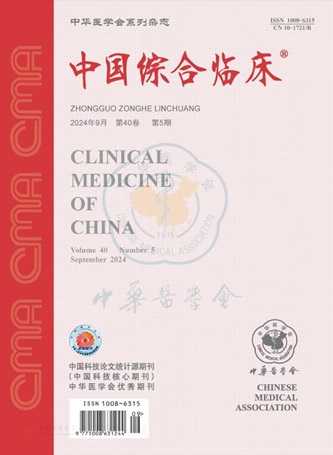脓毒症患者血清胆固醇指标的变化特点及其与预后的关系
引用次数: 0
摘要
目的探讨脓毒症患者血胆固醇变化与预后的关系。方法回顾性分析2014年2月至2018年12月南京医科大学附属南京医院收治的236例脓毒症患者(观察组)的临床资料。将两组患者的一般临床资料、总胆固醇(TC)、低密度脂蛋白胆固醇(LDL-C)、高密度脂蛋白胆固醇(HDL-C)等生化指标与对照组同期236例无脓毒症患者进行比较;脓毒症患者根据预后分为生存组和死亡组,采用多因素Logistic回归分析影响预后的相关因素。结果脓毒症患者生存率为60.6%(143/236),死亡率为39.4%(93/236),生存组143例,死亡组93例。与对照组相比,观察组患者血清TC((2.51±1.20)mmo/L vs(3.42±1.33)mmo/L, t=6.385)、HDL-C((1.62±0.91)mmo/L vs(2.53±0.79)mmo/L, t=5.526)水平均显著降低(均P 0.05)。观察组死亡组患者比生存组患者年龄大((75.4±10.3)岁比(64.3±16.0)岁,t=4.984, P<0.05),血清肌酐(SCr)高于生存组((252.3±65.2)μmol/L比(168.3±47.8)μmol/L, t=5.604, P<0.05),血清TC((2.20±1.46)μmol/L比(2.91±1.12)μmol/L, t=6.157, P<0.05), HDL-C((1.41±0.51)mmo/L比(1.95±0.65)mmo/L, t=5.090, P<0.05)和LDL-C((1.71±0.67)mmo/L比(2.02±0.84)mmo/L, t=4.525,P<0.05)显著低于生存组。Logistic回归分析显示,年龄是脓毒症患者死亡的危险因素(OR=1.035, 95%CI 1.012 ~ 1.049, P=0.008), TC是脓毒症患者预后的保护因素(OR=0.748, 95%CI 0.693 ~ 0.822, P=0.015)。结论败血症患者TC和HDL-C明显降低,且死亡患者的TC和HDL-C明显低于存活患者。TC作为一种保护因子,可作为评价脓毒症患者预后的有效生化指标。关键词:脓毒症;胆固醇;预后;年龄本文章由计算机程序翻译,如有差异,请以英文原文为准。
Changes characteristics of serum cholesterol indicators in sepsis patients and its correlation with prognosis
Objective To explore the relationship between the change of blood cholesterol and prognosis in patients with sepsis. Methods The clinical data of 236 patients with sepsis (observation group) admitted to Nanjing Hospital Affiliated to Nanjing Medical University from February 2014 to December 2018 were analyzed retrospectively.The general clinical data, total cholesterol (TC), low density lipoprotein cholesterol (LDL-C) of the two groups were compared with 236 patients without sepsis in the same period as the control group, high density lipoprotein cholesterol (HDL-C) and other biochemical indexes; sepsis patients were divided into survival group and death group according to the prognosis, and the related factors affecting the prognosis were analyzed by multi factor Logistic regression. Results The survival rate of sepsis patients was 60.6% (143/236), the mortality rate was 39.4% (93/236), 143 cases in survival group and 93 cases in death group.Compared with control group, the levels of serum TC ((2.51±1.20) mmo/L vs.(3.42±1.33) mmo/L, t=6.385) and HDL-C ((1.62±0.91) mmo/L vs.(2.53±0.79) mmo/L, t=5.526) in observation group were significantly lower (all P 0.05). In observation group, the patients in death group were older than those of the survival group ((75.4±10.3) years vs.(64.3±16.0) years, t=4.984, P<0.05), serum creatinine (SCr) was higher than that of survival group((252.3±65.2) μmol/L vs.(168.3±47.8) μmol/L, t=5.604, P<0.05), the levels of serum TC ((2.20±1.46) mmo/L vs.(2.91±1.12) mmo/L, t=6.157, P<0.05), HDL-C ((1.41±0.51) mmo/L vs.(1.95±0.65) mmo/L, t=5.090, P<0.05) and LDL-C ((1.71±0.67) mmo/L vs.(2.02±0.84) mmo/L, t=4.525, P<0.05) were significantly lower than those of survival group.Logistic regression analysis showed that age was the risk factor of death in sepsis patients (OR=1.035, 95%CI 1.012-1.049, P=0.008), and TC was the protective factor on the prognosis of sepsis patients (OR=0.748, 95%CI 0.693-0.822, P=0.015). Conclusion TC and HDL-C were significantly decreased in sepsis patients, while those who died were further decreased than those who survived.As a protective factor TC can be an effective biochemical index to evaluate the prognosis of patients with sepsis. Key words: Sepsis; Cholesterol; Prognosis; Age
求助全文
通过发布文献求助,成功后即可免费获取论文全文。
去求助
来源期刊
CiteScore
0.10
自引率
0.00%
发文量
16855
期刊介绍:
Clinical Medicine of China is an academic journal organized by the Chinese Medical Association (CMA), which mainly publishes original research papers, reviews and commentaries in the field.
Clinical Medicine of China is a source journal of Peking University (2000 and 2004 editions), a core journal of Chinese science and technology, an academic journal of RCCSE China Core (Extended Edition), and has been published in Chemical Abstracts of the United States (CA), Abstracts Journal of Russia (AJ), Chinese Core Journals (Selection) Database, Chinese Science and Technology Materials Directory, Wanfang Database, China Academic Journal Database, JST Japan Science and Technology Agency Database (Japanese) (2018) and other databases.

 求助内容:
求助内容: 应助结果提醒方式:
应助结果提醒方式:


